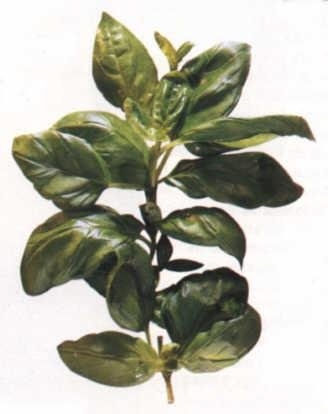It is an annual herbaceous plant, aromatic, of the Lamiaceae family, native to the tropical regions of Central Africa and Southeast Asia that is cultivated in tropical climates.
It reaches 30-130 cm in height, has oval opposite leaves, toothed, silky texture and lustrous green color. The flowers form terminal spikes, are tubular, white or violet in color and, unlike the rest of the family, have the four stamens and pistil resting on the lower lip of the corolla.
It is widely used in Mediterranean cuisine, both fresh and dried, to dress salads, vegetable soups or sauces to accompany pasta dishes or meat stews.
Flowering tops.
Active principles
Contraindicaitons
Precautions
Some cases of diarrhea have been described when fresh basil is used in food use, because it can present pathogens, so it is advisable to wash it well before use.
They have not been described.
At the recommended doses, no side effects are expected.
-.J. Bruneton. Pharmacognosy. Phytochemistry. Medicinal Plants. Editorial Acribia, 2nd edition.
-Monograph of the SEFIT (Spanish Society of Phytotherapy).
-Medicinal Plants and Vegetable Drugs for infusion and tisane. TEEDROGEN Manual by Max Wichtl. Spanish edition by S. Cañigueral, R. Vila and Max Wichtl. International OEMF.
-Sestili P, Ismail T, Calcabrini C, Guescini M, Catanzaro E, Turrini E, et al. The potential effects of Ocimum basilicum on health: a review of pharmacological and toxicological studies. Expert Opin Drug Metab Toxicol. 2018;14(7):679-692.
-.Bower A, Marquez S, de Mejia EG. The health benefits of selected culinary herbs and spices found in the traditional Mediterranean diet. Crit Rev Food Sci Nutr. 2016;56(16):2728-46.
